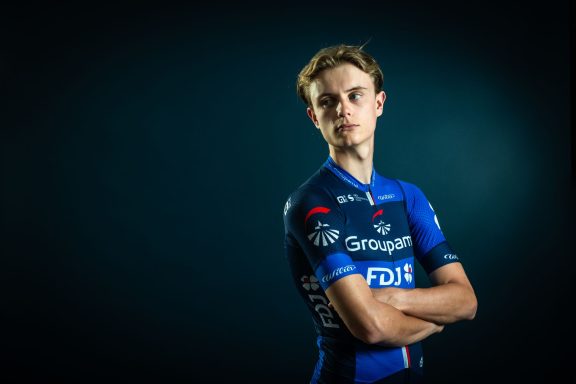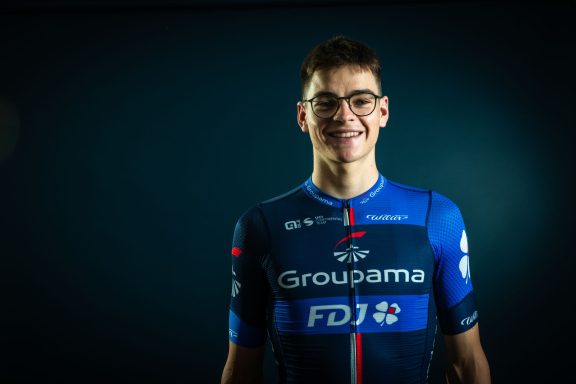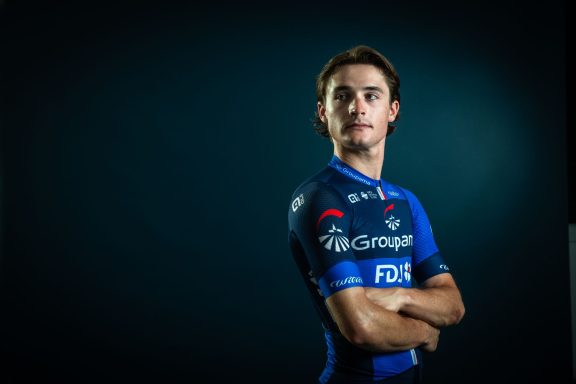The Groupama-FDJ cycling team resumes training. After taking a break in the past few days, the riders are now back on their bike – most of them on home trainers -, in order to gradually get going again. The performance department’s director Frédéric Grappe took advantage of this moment to sheds light on the course of the coming weeks and to explain us how the riders need to be monitored, both physically and mentally, in this lockdown period.
Frédéric, the team’s riders took a break of about 10-15 days. What was the purpose of it?
In a few countries, some were still able to ride outside, but we indeed suggested a break with sports. That roughly matched the first two weeks of lockdown (in France). Some did very little, others tried to stay in shape, but there was no training program whatsoever. They were free to do what they wanted. For some, it was also an opportunity to take a break after a solid start of the season. Since Monday, we have started our first work phase, on home trainers for most of the riders, on the road for those who have the authorization. The main idea is to build a first phase on three weeks, until April 19, in order to keep them sharp and to bring them back in a high-level athlete’s work set-up. For those who stopped 15 days and did not do much, it will be a resuming phase on the first week and we will gradually increase the training load on the second. The third one will be a bit lighter to digest the first fifteen days.
“The key word is motivation”
What scenario do you favour at this point?
For French riders, lockdown is confirmed until April 15, almost until the end of our first work phase. We hope that from this date on, outdoor training will be possible, which would enable us to get to another work phase, on the road this time. We could then be more specific and we could more easily increase the workloads. We are very much aware that we cannot maximize the work on home trainer as we would on the road. If the lockdown were to continue, this second phase would begin on the home trainer, but we would logically increase difficulty. However, each rider will react differently. Some don’t like the home trainer at all, others don’t mind. Some can train outside, others cannot. You have to take into consideration these two parameters and it creates a lot of possibilities. Coaches have to approach this on a case-by-case basis, but the guideline is to continue to stimulate the athlete so that when the time comes, he can build a new phase outside and resume competition in early June. We hope so. This is our goal, and we have to set some. If it doesn’t go this way, we’ll adjust.
How do you cope with such an unpredictable situation?
We have to adapt, that’s part of the job. The key word for us in this situation is motivation. You cannot make someone work if he is not motivated. That is the starting point of everything else, and you have to know how to manage the athlete’s emotional balance; the rider goes through periods of work with a lot of constraints and little pleasure. It is therefore necessary at times to re-inject some pleasure. If we plan three weeks on the home trainer with too much constraint, it can depress some, lead to a mental dropout and it will therefore be counterproductive. It is up to us, coaches, according to the character and personality of each rider, to find the source of motivation so that each session can be efficient. First and foremost, a good coach is someone who knows what answers to bring to the rider’s mental and physical reactions. He doesn’t have to always go his way, but he has to find the right balance between increasing constraints and decreasing pleasure. For each rider, we have to find the balance of this emotional scale and there are some tricks for that.
For example?
First of all, all of our riders have been equipped with a quality home trainer. With it, they can connect to different virtual training platforms, which create routes. These platforms are becoming a real tool of social connection. Some discover it now, others already knew it. They are very well done and will help us a lot during this period. You can train with others, there are different types of course and the coaches can put their training program inside, so that we have our own sessions. There are some really interesting routes and some riders are already starting to get caught up in the game. Somehow, you are playing with your home trainer and it is something we did not have a few years ago.
“Return to competition with a well-harmonized orchestra”
Pleasure looks more obvious for those who have the opportunity to train outdoors.
When an athlete is in very good shape, he wants to take advantage of it, clearly. He doesn’t want to waste his good legs, he wants to maintain his physical condition and going outside allows him to make the most of it, on his real training field. He can enjoy his good feelings more than when he is locked up all the time. The environment in which the athlete performs plays a large part. The same kind of effort, in terms of watts, will not have the same effect depending on whether it is done on a home trainer or outdoors. This is why we cannot ask the same amount of training and the same feelings from an athlete who spends his time on the home trainer and from the one who is outside.
Some say this period is the winter break all over again. What is your opinion?
Let’s take a guitar, and let’s say that when a rider is in good shape, the six strings are tight, tuned. At this point, you then only have to do the final settings, which is playing the right chords. From November to January, we focus on adjusting these strings one after the other, knowing that each one is a different performance ability. You can’t play the right chords until the strings are tuned. This is the reason why the feelings are so special during the winter, and why the legs “sound wrong”. However, the strings of a rider like Stefan Küng, who came out of a good racing block, are already well adjusted. He can therefore play good chords today, which is not the case during winter.
If the guitars are already tuned, the winter’s example cannot be imitated…
No, because everything that the riders did from November to February has not disappeared. They think, and I say ‘think’, that they lose a lot. It could be 10% but it seems huge to them because their feelings are no longer very good. The strings loosen slightly, so they feel like it’s not going well at all. In actual fact, if we would carry out physical quality measurements today, we would notice they don’t lose that much. The goal is to maintain the different capacities as we can work some of them on the home trainer, like explosiveness. Some abilities will be maintained, others will decrease slightly, and others will increase a bit. If we get back on the road on April 19, there will logically be big differences between the team’s riders compared to a regular season. It will then take a period of adjustments during the second work phase to regain the team hegemony. Ideally, that would allow us return to competition with riders at a good physical level and a well-harmonized symphony orchestra. If we consider the squad as an orchestra and each rider as a musician with his own specialty, it is up to us to ensure that this orchestra is well in tune. Then the conductors, that are the sport directors, will come after us to lead the whole thing.
“A large team manages to find solutions to the difficulty”
Is this period a real challenge for the performance department and yourself?
I rather approach it as big break for everyone that we have to manage. Nowadays, we have interesting working tools and we will use them. In any case, you always come out stronger from an exceptional and unpredictable situation when you are able, at some point, to find solutions. This is our job. I always say that a great team is a team that is able to find the right answers when facing difficulty. Whatever the sport, you don’t recognize a great team when everything goes well. Therefore, my role in all this is to suggest and produce, with all my collaborators, solutions for the entire team.
If the Tour is not postponed, are you afraid to witness big differences in terms of performance levels due to the current period?
Let’s assume a road training resumption on April 15. In this case, there will be plenty of time to balance levels ahead of the Tour. It could be more difficult if we can’t ride on the road before mid-May. Right now, some are more fortunate than others to train, but there may also be time lags. Those who ride outside today may be confined tomorrow. Ideally, for cycling, I hope we will be able to get back on the road as quickly as possible, depending on health conditions, of course. But the sooner we get back on the road, the faster there will be a riders’ values levelling, and we all hope for a Tour with athletes at their best.
To conclude, what are the things to do and to avoid in the coming weeks?
Above all, you need to stay calm, relaxed and accept the situation. We talked about it a lot together and the riders got the memo: when you accept it, it is easier to find solutions. Then, you have to manage to set goals even if they may evolve, because without a goal, it is difficult to work. If the health situation requires it, then it will be necessary to be able to make adjustments. However, the set-up we have now allows us to work calmly and without too much doubt, even if everyone is of course in an uncomfortable situation. The nutritional side is naturally important and the riders will get instructions on the matter. What to avoid is nervousness, frustration, fighting against the situation and, as a result, not finding motivation. I repeat, motivation is the key word, and you have to be able to find some for a rider if he doesn’t succeed in doing it by himself.



1 comment
Martin
The 2 April 2020 of 17:41
Consolidate, encourage and push this great cycling outfit. A pity about the pandemic but as was said Groupama-FDJ will adjust themselves to meet the challenges ahead. I love this team